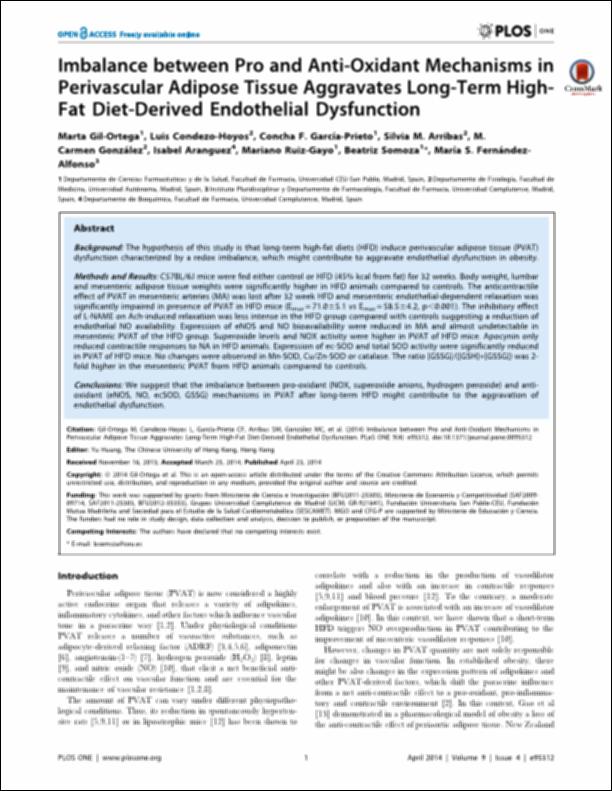Please use this identifier to cite or link to this item:
http://hdl.handle.net/10637/14614Imbalance between Pro and Anti-Oxidant Mechanisms in Perivascular Adipose Tissue Aggravates Long-Term High-Fat Diet-Derived Endothelial Dysfunction
| Title: | Imbalance between Pro and Anti-Oxidant Mechanisms in Perivascular Adipose Tissue Aggravates Long-Term High-Fat Diet-Derived Endothelial Dysfunction |
| Authors : | Gil Ortega, Marta Condezo-Hoyos, Luis García Prieto, Concepción F. Arribas Rodríguez, Silvia Magdalena González García, María Carmen Aránguez, Isabel Ruíz Gayo, Mariano Somoza Hernández, Beatriz Fernández Alfonso, María Soledad |
| Keywords: | Perivascular adipose tissue; Endothelial dysfunction |
| Citation: | Gil-Ortega M, Condezo-Hoyos L, Garcı´a-Prieto CF, Arribas SM, Gonza´lez MC, et al. (2014) Imbalance between Pro and Anti-Oxidant Mechanisms in Perivascular Adipose Tissue Aggravates Long-Term High-Fat Diet-Derived Endothelial Dysfunction. PLoS ONE 9(4): e95312. doi:10.1371/journal.pone.0095312 |
| Abstract: | Background: The hypothesis of this study is that long-term high-fat diets (HFD) induce perivascular adipose tissue (PVAT) dysfunction characterized by a redox imbalance, which might contribute to aggravate endothelial dysfunction in obesity. Methods and Results: C57BL/6J mice were fed either control or HFD (45% kcal from fat) for 32 weeks. Body weight, lumbar and mesenteric adipose tissue weights were significantly higher in HFD animals compared to controls. The anticontractile effect of PVAT in mesenteric arteries (MA) was lost after 32 week HFD and mesenteric endothelial-dependent relaxation was significantly impaired in presence of PVAT in HFD mice (Emax = 71.065.1 vs Emax = 58.564.2, p,0.001). The inhibitory effect of L-NAME on Ach-induced relaxation was less intense in the HFD group compared with controls suggesting a reduction of endothelial NO availability. Expression of eNOS and NO bioavailability were reduced in MA and almost undetectable in mesenteric PVAT of the HFD group. Superoxide levels and NOX activity were higher in PVAT of HFD mice. Apocynin only reduced contractile responses to NA in HFD animals. Expression of ec-SOD and total SOD activity were significantly reduced in PVAT of HFD mice. No changes were observed in Mn-SOD, Cu/Zn-SOD or catalase. The ratio [GSSG]/([GSH]+[GSSG]) was 2- fold higher in the mesenteric PVAT from HFD animals compared to controls. Conclusions: We suggest that the imbalance between pro-oxidant (NOX, superoxide anions, hydrogen peroxide) and antioxidant (eNOS, NO, ecSOD, GSSG) mechanisms in PVAT after long-term HFD might contribute to the aggravation of endothelial dysfunction. |
| URI: | http://hdl.handle.net/10637/14614 |
| Rights : | http://creativecommons.org/licenses/by-nc-nd/4.0/deed.es OpenAccess |
| ISSN: | 1932-6203 |
| Issue Date: | 23-Apr-2014 |
| Center : | Universidad San Pablo-CEU |
| Appears in Collections: | Facultad de Farmacia |
Items in DSpace are protected by copyright, with all rights reserved, unless otherwise indicated.


